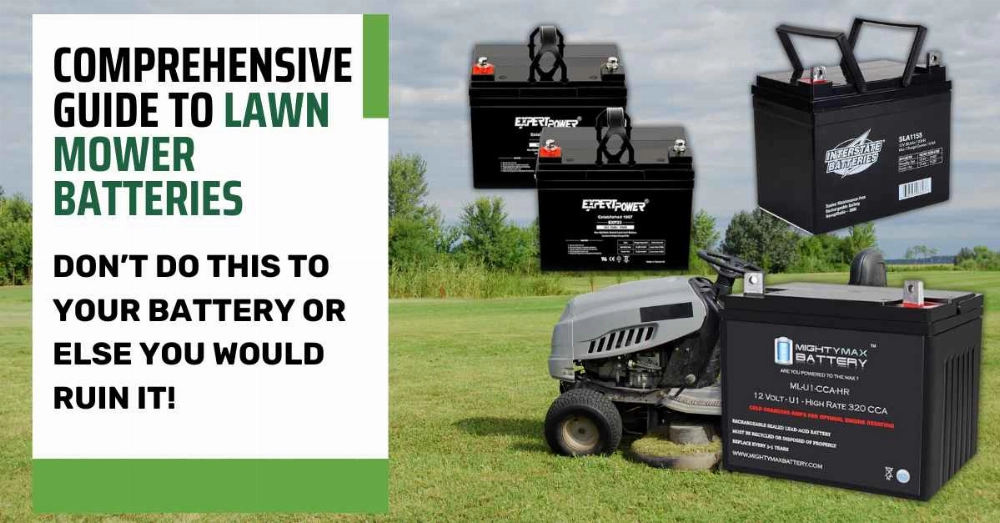Lawn mower batteries play a vital role in the proper functioning of lawn mowers, powering the engine and various electrical components. Understanding the average lifespan of a lawn mower battery is essential for planning maintenance and ensuring your mower runs smoothly throughout its life. This article will explore the different types of lawn mower batteries, factors affecting their lifespan, helpful maintenance tips, and common causes of battery failure.
Part 1: Types of Lawn Mower Batteries

Lawn mower batteries come in several types, each with unique characteristics that affect their performance and durability. Here’s a closer look at the most common types:
1. Lead-Acid Batteries
Lead-acid batteries are a traditional choice for many gasoline-powered lawn mowers. These batteries are relatively inexpensive and reliable but can be heavy and require regular maintenance. There are two main subtypes:
- Flooded Lead-Acid Batteries: These batteries require regular electrolyte level checks and are susceptible to overcharging.
- AGM (Absorbent Glass Mat) Batteries: A sealed, maintenance-free version that is less prone to spills, making it suitable for use in various orientations.
2. Lithium-Ion Batteries

Lithium-ion batteries are increasingly popular in electric lawn mowers due to their lightweight design and long lifespan. They boast quick charging times and require minimal maintenance, making them perfect for regular use. For a deeper dive into lithium-ion battery capacity, refer to our Ultimate Guide to Li-ion Battery Capacity Explained.
3. Nickel-Cadmium (Ni-Cd) Batteries
Ni-Cd batteries were once common in older models but are now less frequently used due to their lower capacity and environmental concerns. While they can withstand deep discharges, their lifespan is generally shorter than that of lithium-ion batteries.
4. Gel Batteries
Gel batteries are similar to AGM batteries in that they feature a sealed, maintenance-free design.
Understanding these battery types will help you make an informed decision when choosing a lawn mower and guide you in caring for your battery.
Part 2: Average Lifespan of Lawn Mower Batteries
The lifespan of a lawn mower battery depends on the type of battery used:
- Lead-Acid Batteries: Typically last 3 to 5 years with proper care.
- Lithium-Ion Batteries: Can last 5 to 10 years, depending on usage and maintenance.
- Ni-Cd Batteries: These batteries generally last about 2 to 3 years but are becoming less common in modern lawn mowers.
These averages can vary based on several factors, which we will discuss in the next section.
Part 3: Factors Affecting Lawn Mower Battery Life
Several key factors influence the lifespan of a lawn mower battery:
- Battery Quality: Higher-quality batteries are generally made with better materials and construction, resulting in a longer lifespan.
- Usage Patterns: How often and how long you use your lawn mower can affect the battery’s lifespan. Regular mowing helps keep the battery charged, but excessive use without proper rest can lead to quicker wear.
- Temperature Effects: Extreme temperatures, whether hot or cold, can accelerate battery aging. Storing your lawn mower in a climate-controlled environment helps extend battery life.
- Maintenance Practices: Regularly check connections, clean terminals, and maintain proper fluid levels in lead-acid batteries to significantly extend their lifespan. Neglecting maintenance can result in corrosion or poor connections.
- Charging Habits: Always follow the manufacturer’s charging guidelines and avoid overcharging or undercharging, which can prematurely damage the battery. For detailed insights on safe charging practices, consider reading our article on How to Charge Lithium Battery Safely: 2024 Tips.
By understanding these factors, you can take proactive steps to maximize your battery’s lifespan and maintain reliable lawn mower performance.
Part 4: How to Extend the Life of Your Lawn Mower Battery
Follow these practical tips to maximize the lifespan of your lawn mower battery:
- Regular Maintenance: Clean the battery terminals regularly to prevent corrosion and check the electrolyte levels in lead-acid batteries.
- Proper Storage: Store your lawn mower in a cool, dry place when not in use to avoid extreme temperatures affecting the battery.
- Avoid Overuse: Do not mow for extended periods continuously; allow the battery to cool down between uses.
- Correct Charging: Always follow the manufacturer’s charging instructions, being careful to avoid both overcharging and undercharging, which can damage the battery.
By following these tips, you can help your lawn mower battery last longer and perform efficiently.
Part 4. How to Extend Your Lawn Mower Battery Life
Properly maintaining your lawn mower battery extends its life and ensures reliable performance. Here are some essential practices to keep in mind:
Regularly Check Electrolyte Levels
For lead-acid batteries, regularly check the electrolyte levels. Add distilled water as needed to maintain the correct levels. This practice helps keep the battery healthy and ensures efficient operation.
Follow Proper Charging Procedures
Always use a charger designed specifically for your type of battery. Avoid completely discharging the battery before recharging, as this can significantly shorten its lifespan.
Proper Storage
If you won’t be using your mower for an extended period, store it in a cool, dry place. Disconnect the battery for long-term storage to prevent unnecessary drain.
Regular Use
Frequent use helps keep the battery healthy. If you don’t use your lawn mower often, consider investing in a trickle charger to keep the battery at an optimal charge level without overcharging.
Temperature Control
Avoid exposing your lawn mower to extreme temperatures, whether hot or cold. Storing it in a climate-controlled environment will help maintain optimal battery performance.
Adopting these practices will extend your lawn mower battery’s life and ensure efficient operation when needed.
Part 5. Why Lawn Mower Batteries Fail
Understanding what causes battery failure can help you prevent unexpected breakdowns. Here are the most common issues to watch out for:
Terminal Corrosion
Over time, corrosion can build up on battery terminals, reducing connectivity and affecting power output. Clean the terminals regularly to avoid this issue.
Deep Discharge
Allowing the battery to completely discharge before recharging can cause significant damage, especially for lead-acid batteries that need to maintain a minimum charge.
Extreme Temperature Exposure
Whether hot or cold, extreme temperatures can damage the internal components of the battery, leading to reduced performance or failure.
Long Periods of Inactivity
Leaving a battery unused for extended periods can lead to sulfation in lead-acid batteries or loss of capacity in lithium-ion batteries. Regular charging can help prevent this.
Improper Charging Practices
Using the wrong charger or failing to follow charging guidelines can lead to overcharging or undercharging, both of which can shorten the battery’s lifespan.
By understanding these issues, you can take steps to protect your battery and ensure smooth lawn mower operation.
Part 6. Signs Your Lawn Mower Battery Needs Replacement
Recognizing when your lawn mower battery needs replacing is crucial for maintaining optimal performance. Watch out for these signs:
Hard Starting
If your lawn mower struggles to start or requires multiple attempts, it may indicate that the battery is failing and needs to be replaced.
Shorter Run Time
If you notice that your lawn mower runs for a shorter amount of time before needing a charge, the battery may be wearing out.
Corrosion or Leaks
Visible corrosion on the terminals or any leaking fluid from the battery are clear indications that a replacement is needed.
Being vigilant for these signs will help you avoid unexpected breakdowns and ensure smooth operation throughout the mowing season.
Part 7. Lawn Mower Battery Replacement Costs
The cost of replacing a lawn mower battery depends on the type and brand of battery you choose:
Lead-Acid Batteries
Typically, lead-acid batteries range in price from $30 to $100, depending on their quality and capacity.
Lithium-Ion Batteries
Lithium-ion batteries are more expensive, ranging from $100 to $300. However, they offer a longer lifespan and better performance.
Nickel-Cadmium Batteries (NiCd)
These batteries cost around $40 to $80, although they are becoming less common in newer models.
When planning a battery replacement, consider both the initial cost and the long-term benefits in terms of performance and longevity.







